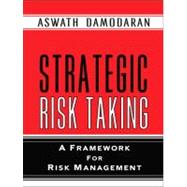
| Strategic Risk Taking | |
| A Framework for Risk Management (0131990489) | |
| Aswath Updated 4/17/ 2007 | |
| Front Matter | |
| Road Map Parts 1-4--The Economists View of Risk Aversion and the Behavioral Response 1 page; 2 figure | |
| What Is Risk?--9 pages; 1 figure | |
| Why Do We Care about Risk?--26 pages; 6 figures | |
| What Do We Think about Risk?--31 pages; 5 figures | |
| How Do We Measure Risk?--36 pages; 27 figures Parts 5-8-- Risk Assessment: Tools and Techniques 1 page | |
| Risk-Adjusted Value--48 pages; 5 figures | |
| Probabilistic Approaches: Scenario Analysis, Decision Trees, and Simulations--42 pages; 18 figures | |
| Value at Risk (VAR)--32 pages; | |
| Real Options--50 pages; 21 figures Parts 9-12-- Risk Management: The Big Picture 1 page | |
| Risk Management: The Big Picture--33 pages; 15 figures | |
| Risk Management: Profiling and Hedging--34 pages; 7 figures | |
| Strategic Risk Management--29 pages ; 6 figures | |
| Risk Management: First Principles--13 pages | |
| Index | |
| Table of Contents provided by Publisher. All Rights Reserved. |
The New copy of this book will include any supplemental materials advertised. Please check the title of the book to determine if it should include any access cards, study guides, lab manuals, CDs, etc.
The Used, Rental and eBook copies of this book are not guaranteed to include any supplemental materials. Typically, only the book itself is included. This is true even if the title states it includes any access cards, study guides, lab manuals, CDs, etc.